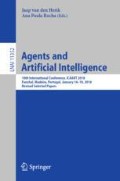Abstract
In this work, we compare different explanation generation and validation methods for semantic search pattern-based retrieval results returned by a case-based framework for support of early conceptual design phases in architecture. Compared methods include two case- and rule-based explanation engines, the third one is the discriminant analysis-based method for explanation and validation prediction and estimation. All of the explanation methods use the same data set for retrieval and subsequent explainability operations for results. We describe the main structure of each method and evaluate their quantitative validation performance against each other. The goal of this work is to examine which method performs better under which circumstances, at which point in time, and how good the potential explanation ant its validation can be predicted in general. To evaluate these issues, we compare not only the general performance, i.e., the average rate of valid explanations but also how the validation rate changes over time using a number of time steps for this comparison. We also show for which search pattern type which methods perform better.
Access this chapter
Tax calculation will be finalised at checkout
Purchases are for personal use only
References
Ayzenshtadt, V., Espinoza-Stapelfeld, C.A., Langenhahn, C., Althoff, K.D.: Multi-agent-based generation of explanations for retrieval results within a case-based support framework for architectural design. In: Proceedings of the 10th International Conference on Agents and Artificial Intelligence. International Conference on Agents and Artificial Intelligence (ICAART-18), Scitepress (2018)
Aamodt, A.: Explanation-driven case-based reasoning. In: Wess, S., Althoff, K.-D., Richter, M.M. (eds.) EWCBR 1993. LNCS, vol. 837, pp. 274–288. Springer, Heidelberg (1994). https://doi.org/10.1007/3-540-58330-0_93
Roth-Berghofer, T.R.: Explanations and case-based reasoning: foundational issues. In: Funk, P., González Calero, P.A. (eds.) ECCBR 2004. LNCS (LNAI), vol. 3155, pp. 195–209. Springer, Heidelberg (2004). https://doi.org/10.1007/978-3-540-28631-8_29
Cassens, J., Kofod-Petersen, A.: Designing explanation aware systems: the quest for explanation patterns. In: ExaCt, pp. 20–27 (2007)
Broekens, J., Harbers, M., Hindriks, K., van den Bosch, K., Jonker, C., Meyer, J.-J.: Do you get it? user-evaluated explainable BDI agents. In: Dix, J., Witteveen, C. (eds.) MATES 2010. LNCS (LNAI), vol. 6251, pp. 28–39. Springer, Heidelberg (2010). https://doi.org/10.1007/978-3-642-16178-0_5
Harbers, M., van den Bosch, K., Meyer, J.J.: Design and evaluation of explainable BDI agents. In: 2010 IEEE/WIC/ACM International Conference on Web Intelligence and Intelligent Agent Technology (WI-IAT), vol. 2, pp. 125–132. IEEE (2010)
Voss, A.: Case design specialists in FABEL. In: Issues and Applications of Case-Based Reasoning in Design, pp. 301–335 (1997)
Oxman, R., Oxman, R.: Precedents: memory structure in design case libraries. In: CAAD Futures. vol. 93, pp. 273–287 (1993)
Flemming, U.: Case-based design in the SEED system. Autom. Constr. 3, 123–133 (1994)
Lai, I.C.: Dynamic idea maps: a framework for linking ideas with cases during brainstorming. Int. J. Architectural Comput. 3, 429–447 (2005)
Lin, C.J.: Visual architectural topology. In: Open Systems: Proceedings of the 18th International Conference on Computer-Aided Architectural Design Research in Asia, pp. 3–12 (2013)
Inanc, B.S.: Casebook. an information retrieval system for housing floor plans. In: The Proceedings of 5th Conference on Computer Aided Architectural Design Research (CAADRIA), pp. 389–398 (2000)
Richter, K., Heylighen, A., Donath, D.: Looking back to the future-an updated case base of case-based design tools for architecture. In: Knowledge Modelling-eCAADe (2007)
Richter, K.: Augmenting Designers’ Memory: Case-based Reasoning in Architecture. Logos-Verlag, Berlin (2011)
Richter, K.: What a shame-why good ideas can’t make it in architecture: a contemporary approach towards the case-based reasoning paradigm in architecture. In: FLAIRS Conference (2013)
Sabri, Q.U., Bayer, J., Ayzenshtadt, V., Bukhari, S.S., Althoff, K.D., Dengel, A.: Semantic pattern-based retrieval of architectural floor plans with case-based and graph-based searching techniques and their evaluation and visualization. In: ICPRAM, pp. 50–60 (2017)
Ayzenshtadt, V., et al.: Comparative evaluation of rule-based and case-based retrieval coordination for search of architectural building designs. In: Goel, A., Díaz-Agudo, M.B., Roth-Berghofer, T. (eds.) ICCBR 2016. LNCS (LNAI), vol. 9969, pp. 16–31. Springer, Cham (2016). https://doi.org/10.1007/978-3-319-47096-2_2
Jackson, M.: Problem analysis using small problem frames. S. Afr. Comput. J. 47–60 (1999)
Espinoza, C.: Case-based classification of explanation expressions in search results of a retrieval system for Support of the early conceptual design phase in architecture. Bachelor Thesis. University of Hildesheim (2018)
Bayer, J., et al.: Migrating the classical pen-and-paper based conceptual sketching of architecture plans towards computer tools - prototype design and evaluation. In: Lamiroy, B., Dueire Lins, R. (eds.) GREC 2015. LNCS, vol. 9657, pp. 47–59. Springer, Cham (2017). https://doi.org/10.1007/978-3-319-52159-6_4
Author information
Authors and Affiliations
Corresponding author
Editor information
Editors and Affiliations
Rights and permissions
Copyright information
© 2019 Springer Nature Switzerland AG
About this paper
Cite this paper
Espinoza-Stapelfeld, C., Eisenstadt, V., Althoff, KD. (2019). Comparative Quantitative Evaluation of Distributed Methods for Explanation Generation and Validation of Floor Plan Recommendations. In: van den Herik, J., Rocha, A. (eds) Agents and Artificial Intelligence. ICAART 2018. Lecture Notes in Computer Science(), vol 11352. Springer, Cham. https://doi.org/10.1007/978-3-030-05453-3_3
Download citation
DOI: https://doi.org/10.1007/978-3-030-05453-3_3
Published:
Publisher Name: Springer, Cham
Print ISBN: 978-3-030-05452-6
Online ISBN: 978-3-030-05453-3
eBook Packages: Computer ScienceComputer Science (R0)

